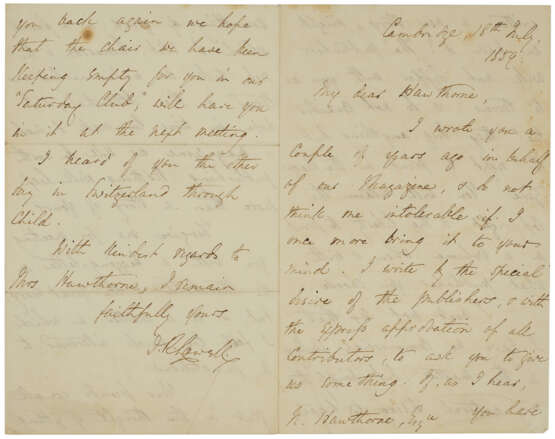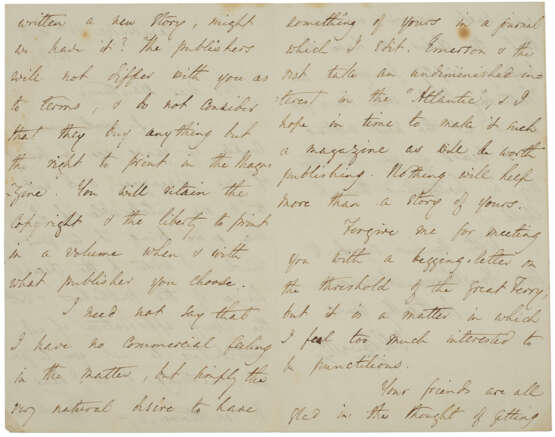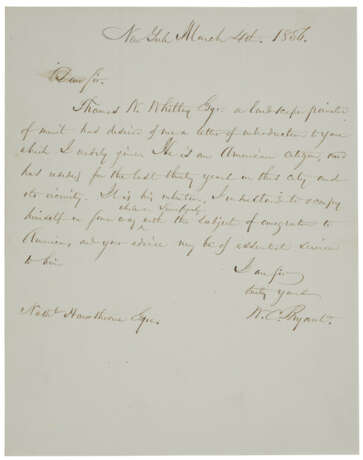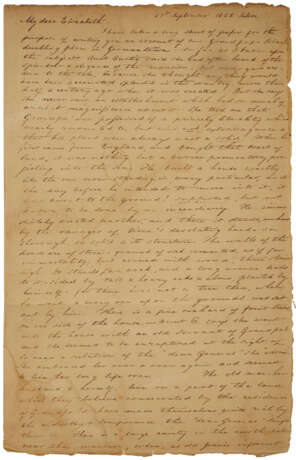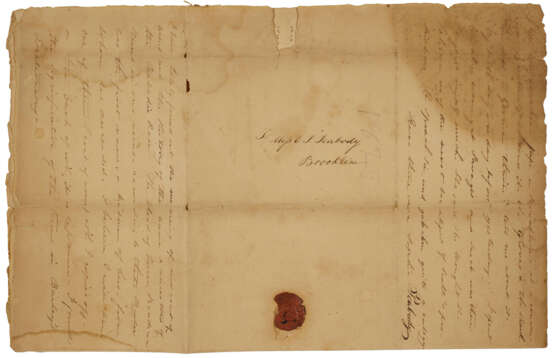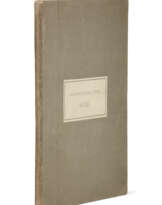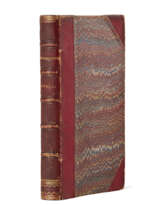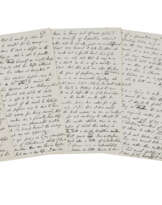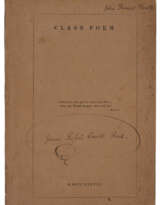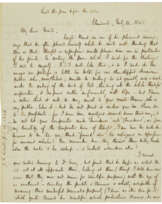ID 967522
Lot 322 | Soliciting a submission from Nathaniel Hawthorne
Valeur estimée
$ 1 500 – 2 500
Four pages, bifolium, 176 x 111mm (a few spots of foxing).
"I hope in time to make it such a magazine as will be worth publishing. Nothing will help more than a story of yours."
Soliciting additional stories from Hawthorne for The Atlantic Monthly. Looking forward to Hawthorne's return to America after seven years in Europe, Lowell, in his role as the founding editor of The Atlantic Monthly, expresses his hope that Hawthorne too will contribute a piece: "I wrote you a couple of years ago in behalf of our Magazine, & do not think me intolerable if I once more bring it to your mind. I write by the special desire of the publishers, & with the express approbation of all contributors, to ask you to give us something. If, as I hear, you have written a new story, might we have it? The publishers will not differ with you as to terms ... I need not say that I have no commercial feeling in the matter, but simply the very natural desire to have something of yours in a journal which I edit. Emerson [Ralph Waldo Emerson] & the rest take an undiminished interest in the 'Atlantic', & I hope in time to make it such a magazine as will be worth publishing. Nothing will help more than a story of yours. Forgive me for meeting you with a begging letter on the threshold of the Great Ferry, but it is a matter in which I feel too much interest to be punctilious. Your friends are all glad in the thought of getting you back again, we hope that the chair we have been keeping empty for you in our "Saturday Club", will have you in it."
[With:] BRYANT, William Cullen (1794-1878). Autograph letter signed ("W.C. Bryant") to Nathaniel Hawthorne, New York, 4 March 1856. One page, bifolium, 248 x 195mm (mild contemporary ink smudge in salutation). Introducing the landscape painter Thomas W. Whitley. * HAWTHORNE, Sophia Peabody (1809-1871). Autograph letter signed ("Sophia") to her sister Elizabeth Palmer Peabody, Salem, 23 September 1825. Four pages, bifolium, 320 x 200mm (soiling and toning with dampstains, mild chipping and tears at margins, loss to second leaf from seal tear). A sixteen-year-old Sophia Peabody writes a lengthy letter concerning their Grandfather Joseph Pearse Palmer (1750 - ca. 1797), including a story of a heated disagreement between "Granpapa" and "Governor [John] Hancock," who "rose in a towering passion and swore his utter ruin!" * PEABODY, Elizabeth Palmer (1804-1894). Autograph letter signed ("E.P.P") to Mary Channing Eustis, [Philadelphia,] 28 October 1876. 32 pages, 210 x 137mm bifolia with original transmittal envelope. A lengthy letter concerning the emotional fallout stemming from the marriage of Rose Hawthorne, the third and youngest daughter of Nathaniel and Sophia Hawthorne, and George Parsons Lathrop. Lathrop had originally planned to wed Rose's older sister Una, but when he was asked by the eldest Hawthorne son, Julian to accompany Una and Rose back from Europe after the death of their mother Sophia in 1871, Rose managed to woo Lathrop, much to the consternation of Julian, and most especially, Una, who was given to fits of insanity (Peabody's words, not ours) concerning the engagement.
| Artiste: | James Russell Lowell (1819 - 1891) |
|---|---|
| Lieu d'origine: | Etats-Unis |
| Catégorie maison de vente aux enchères: | Lettres, documents et manuscrits |
| Artiste: | James Russell Lowell (1819 - 1891) |
|---|---|
| Lieu d'origine: | Etats-Unis |
| Catégorie maison de vente aux enchères: | Lettres, documents et manuscrits |
| Adresse de l'enchère |
CHRISTIE'S 20 Rockefeller Plaza 10020 New York Etats-Unis | ||||||||||||||
|---|---|---|---|---|---|---|---|---|---|---|---|---|---|---|---|
| Aperçu |
| ||||||||||||||
| Téléphone | +1 212 636 2000 | ||||||||||||||
| Fax | +1 212 636 4930 | ||||||||||||||
| Conditions d'utilisation | Conditions d'utilisation | ||||||||||||||
| transport |
Service postal Service de messagerie ramassage par vous-même | ||||||||||||||
| Modes de paiement |
Virement bancaire | ||||||||||||||
| Heures d'ouverture | Heures d'ouverture
|
